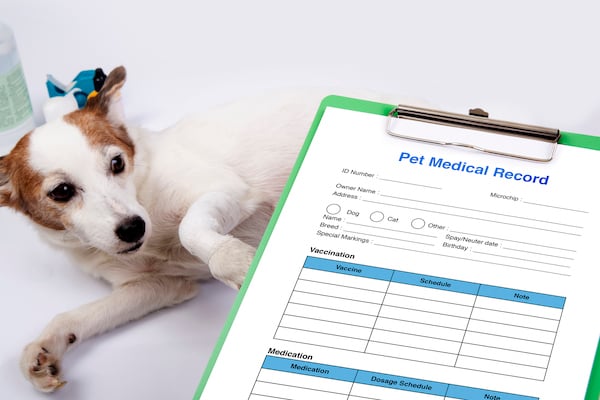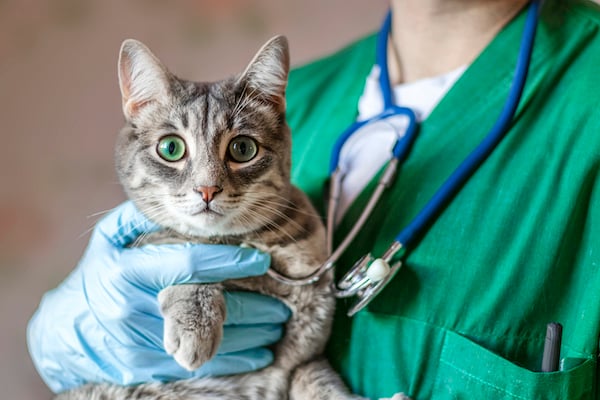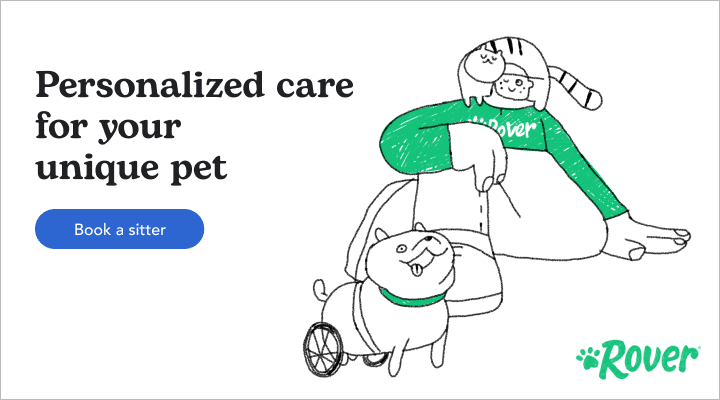- This post contains affiliate links. Read more here.
- Not a substitute for professional veterinary help.
Pet insurance is, for the most part, a lot like human health insurance: it’s there to protect you financially in the event of accidents or illnesses that see your pet racking up the vet bills. But it differs from your own health plan in one especially critical way: pre-existing conditions.
Virtually no pet insurance company will cover the treatment of any medical condition your pet had before you bought pet insurance.
It’s one of the trickiest hurdles pet parents have to navigate when shopping for a plan: Is pet insurance still worth it if your dog or cat wouldn’t be covered for the medical conditions they’ve been diagnosed with in the past?
Read on for our answers to common questions about pre-existing conditions and what you can do to find a policy that works for you.
What Are Pre-Existing Conditions?
Pre-existing conditions are health issues that have been detected (either through a formal diagnosis or a record of symptoms) before you purchased your pet insurance policy. Interested in comparing plans to get the best coverage for your pet? Get started below.
When you take out a policy, your provider will look at your pet’s medical records. Some companies request that your pet has a full medical exam prior to enrollment, while others will ask for a copy of your pet’s medical records, either when you sign on or at the time of your first claim.
Your insurance provider will then use that information to determine what will be considered a pre-existing condition. Treatments for pre-existing conditions won’t ever be covered.

andpstock001 via iStock
If you think your pet is likely to have some pre-existing conditions, here’s what you should be on the lookout for when shopping for a policy:
- Long waiting periods, especially for knee and hip issues. Waiting periods are the amount of time you have to wait between when your policy goes into effect and when your insurance will cover treatment for a given condition. If your pet develops symptoms during a waiting period, they won’t be covered for that condition when it’s over.
- “Curable” pre-existing conditions are health issues that predate your policy’s start date but can be satisfactorily resolved with no expectation of recurrence. Some pet insurance providers will cover curable pre-existing conditions, but the definition of “curable” varies, so it’s worth taking a close look at your policy.
- Bilateral conditions are medical conditions that can occur on either side of the body—like knee and hip injuries. If a bilateral condition your pet had before you got insurance suddenly presents on the other side, even if there were no prior symptoms, it will be treated as a pre-existing condition.
- A medical history review can help. A few companies, notably Figo, will allow you to request a medical history review or “transparency report” after you’ve been enrolled for a month—which means your insurance company will look at your pet’s medical records and tell you up front what they’ll consider a pre-existing condition so you can modify or cancel your plan.
- If you’re switching pet insurance providers, remember that your pre-existing conditions will likely reset; your new insurance company will consider anything that happened on your old insurance company’s watch a pre-existing condition.
How Pre-Existing Conditions Affect Your Pet’s Insurance
Here’s what a pre-existing condition might look like in practice.
Let’s say that at your Dachshund’s annual checkup last year, your vet spotted some early warning signs of Intervertebral Disc Disease and recommended a joint supplement. Shortly after that, you purchased pet insurance. Now a year has passed, and your vet officially diagnoses IVDD and recommends back surgery to relieve the pressure on your dog’s spine. Will your pet insurance policy cover it?

NORRIE3699 via iStock
Unfortunately, it probably won’t. Your pet’s medical record will show that the symptoms of disc disease predate your policy, which makes it likely that your insurance company will consider disc disease—and most spinal conditions—a pre-existing condition.
If, however, your dog gets into medical trouble that’s unrelated to spinal disease and any other pre-existing conditions (sprains a paw, for example, or eats a sock), your pet insurance company should be on the hook.
Last, let’s imagine that you did get pet insurance before you or your vet noticed any signs of disc disease. Your vet recommends surgery, and your insurance policy covers it. Your pup recovers, but after another couple years, your vet recommends another spinal procedure. Will your pet insurance policy cover that?
They certainly should. A pre-existing condition isn’t “any condition that your pet has had before”—it’s just a condition that predates your insurance policy.
Things get a little more complicated when we consider bilateral conditions—conditions that can occur on either side of the body.
Because an injury on one side increases the likelihood of injury on the other, most pet insurance companies treat bilateral conditions as pre-existing conditions.
Here’s an example: Imagine that several years ago, your dog’s cruciate ligament on the left side ruptured. You brought them in for surgery, and now they’re good as gold. You buy pet insurance, and two years later, your dog ruptures their cruciate ligament on the right side. It’s a different leg that showed no signs of problems prior to your policy’s start date, and you’ve long since passed all your insurance company’s waiting periods, so you should be covered, right?
Unfortunately, it’s unlikely. Most insurance companies will consider the same injury on the other side of your pet’s body a bilateral condition—meaning it counts as a pre-existing condition.
But if you took out your insurance policy before symptoms of a cruciate rupture appeared on either side, a good insurance policy should cover both surgeries.
How Is a Pre-Existing Condition Different from a Congenital or Hereditary Condition?
A hereditary condition is a medical disorder that’s inherited genetically, while a congenital condition is one that develops in utero and is present from birth. Both sound like they would be considered pre-existing conditions—but a good pet insurance plan won’t necessarily regard either hereditary or congenital conditions as pre-existing if the symptoms don’t show up before your policy goes into effect.

Fly_dragonfly via iStock
If your pet’s breed is prone to hereditary health issues, it’s a good idea to scrutinize your policy’s stance on them. You’ll want to be on the lookout for
- Knee and hip waiting periods. Large breed dogs are especially prone to knee and hip problems, and those conditions have the longest waiting periods. If symptoms show up in a waiting period, your pet won’t be covered for them when it’s over. Pumpkin and Spot are some of the only companies that offer hip and knee waiting periods of just 15 days, while Prudent Pet and Fetch will let you waive a six-month waiting period if an exam immediately after your policy’s start date comes back clean.
- Age restrictions. Some companies simply won’t cover treatment for hereditary conditions if your pet enrolls after a certain age. Healthy Paws, for example, won’t cover hip dysplasia if your pet is over the age of six at the time of enrollment—even if they haven’t shown any signs of the disease.
Not sure what hereditary conditions your pet is prone to? You can ask your vet or research what conditions affect dogs by breed and age. This can help you determine whether you need a plan that offers coverage with shorter waiting periods.
As for congenital conditions, coverage depends on whether symptoms present immediately or not. Congenital heart disease, for example, may not be immediately obvious. If you purchase a policy before symptoms appear, a good provider should cover treatment.
Because policies on hereditary and congenital conditions vary from company to company, it’s worth checking out a prospective policy’s fine print on both and doing some comparison shopping.
How Do “Treatable” or “Curable” Pre-Existing Conditions Affect Pet Insurance?
Though no pet insurance company will cover a pre-existing condition, some will cover “treatable” and “curable” pre-existing conditions. These typically include conditions that
- Were fully resolved, with no expectation that they would reoccur
- Have presented no symptoms within a policy-specific window, typically between 6 and 18 months
- Haven’t occurred often enough pre-insurance to be considered chronic
- Aren’t subject to a long waiting period (like knee, ligament, and hip issues)
- Aren’t bilateral
Definitions and waiting periods vary from company to company, but an exemption for a “curable” pre-existing condition might look like this:
Imagine that last year, your cat had a urinary tract infection, and you went to the vet for antibiotics. The pills cleared it up, and your cat was right as rain for the next six months. You then purchase pet insurance, and the following month, your cat gets another UTI.

Yelena Shander via iStock
If you submit a claim for your pet’s treatment, your pet insurance is likely to reimburse you for it, provided that enough time has elapsed since your pet’s last pre-insurance treatment.
Pumpkin and Spot, for example, would likely cover your cat’s UTI as long as six consecutive months had passed since the last appearance of symptoms. Prudent Pet and Fetch would make you wait a year, and ManyPets would have you wait 18 months.
There is, however, no industry consensus on how to define or cover “curable” conditions.
For example, if your cat had just the one UTI prior to your policy’s start date, that’s likely covered. But if your cat had a history of chronic UTIs before you enrolled, your chances of finding the next UTI covered are slimmer—and could vary a lot between providers.
Do Pre-Existing Conditions Affect My Premiums?
No—you can’t be denied coverage or have your premiums raised as a result of pre-existing conditions. Nor can your rate go up based on the number of claims you make.
What will raise your premiums, however, is your pet’s age. Older pets are more expensive to insure. If you see your rates going up over the years, that’s probably time and rising veterinary costs at work—not pre-existing conditions.

Capuski via iStock
Should I Still Get Pet Insurance Even If My Pet Has a Pre-Existing Condition?
The simple answer is that it depends on your situation—and how much financial protection you want for when the “what-ifs” happen.
One example is cancer. Even if your pet has had two knee surgeries, chronic UTIs, and a dozen ear infections, it’s likely that a policy you buy today would still cover you for cancer treatment.
According to the American Veterinary Medical Association, almost half of dogs over the age of ten will develop cancer. Successful treatment is more possible now than ever before—but the cost can easily exceed $10,000.
Pet insurance will undoubtedly have been a good deal if your pet gets cancer.
And what if they don’t? It’s true that you’re unlikely to find most of a very old pet’s ailments covered, in which case it might make more sense to rely on your savings account, especially if you’re confident you could cover a worst-case scenario.
But if your pet only has one or two pre-existing conditions, there’s a whole world of accidents and illnesses out there that would likely be covered.
Ultimately, you’re the expert on your pet and your finances and best equipped to know what’s right for you. Get some quotes, do some math, and weigh some budgets—we’re rooting for you!
What’s the Best Pet Insurance for Pre-Existing Conditions?
The best pet insurance for a pet with pre-existing conditions is one that targets the accidents and illnesses your pet is still vulnerable to in a way that works for your budget.
Here’s what you can do to find the right plan for a pet with pre-existing conditions:
- Choose a plan with the widest possible definition of “curable” pre-existing conditions.
- Look for policies with short waiting periods for conditions your pet hasn’t yet developed but could be vulnerable to given their breed or history.
- If you’re not sure what in your pet’s medical record will count as a pre-existing condition, consider a provider that offers a medical history review so you can make an informed decision.
- Consider choosing a high deductible and low reimbursement rate to keep your plan’s monthly costs low. You’ll be protected against large financial disasters like cancer, but you won’t be paying extra for an insurance policy that won’t cover many of your pet’s common treatments.
To review the strongest providers and their policies, check out “The Best Pet Insurance: A Pet Parent’s Guide.”
Further Reading
- The Best Pet Insurance: A Pet Parent’s Guide
- Is Pet Insurance Worth It? How To Know If It’s a Good Deal for Your Pet
- What Does Pet Insurance Cover, and How Does It Work? A Beginner’s Guide
- How To Choose the Right Insurance for Your Pet
- How Much Does Pet Insurance Cost?
- The Best Pet Insurance Wellness Plans: How Preventive Care Add-Ons Work
- What To Know About Waiting Periods and Pet Insurance
- What Are Pet Insurance Deductibles, and How Do You Pick One?
- When Should You Get Pet Insurance?
- Savings Account Versus Pet Insurance: Which Is Better?
Insurance advice, products, and links contained in this article are currently intended for and only available in the states where Rover Pet Insurance Services, LLC is currently licensed as an insurance producer. As we expand our licensing to other states we will update our websites and links.
If you are located in a state in which we are not currently licensed, but would like to learn more about pet insurance products available in your state, you may contact a licensed insurance agent or broker in your state.
The information provided below is offered for educational and informational purposes only. If you have questions regarding particular plans, you should reach out to your insurance company for more information.





